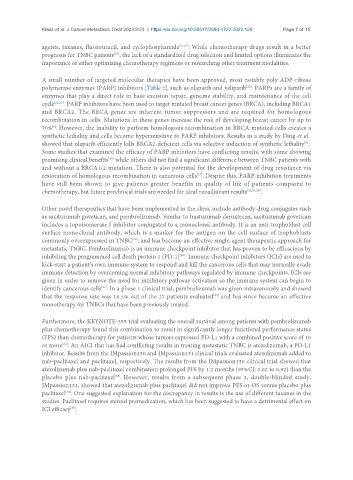Page 433 - Read Online
P. 433
Klaas et al. J Cancer Metastasis Treat 2023;9:23 https://dx.doi.org/10.20517/2394-4722.2022.125 Page 7 of 15
agents, taxanes, fluorouracil, and cyclophosphamide [21,23] . While chemotherapy drugs result in a better
[24]
prognosis for TNBC patients , the lack of a standardized drug selection and limited options illuminates the
importance of either optimizing chemotherapy regimens or researching other treatment modalities.
A small number of targeted molecular therapies have been approved, most notably poly ADP-ribose
polymerase enzymes (PARP) inhibitors [Table 2], such as olaparib and veliparib . PARPs are a family of
[22]
enzymes that play a direct role in base excision repair, genome stability, and maintenance of the cell
cycle [22,25] . PARP inhibitors have been used to target mutated breast cancer genes (BRCA), including BRCA1
and BRCA2. The BRCA genes are inherent tumor suppressors and are required for homologous
recombination in cells. Mutations in these genes increase the risk of developing breast cancer by up to
[9]
70% . However, the inability to perform homologous recombination in BRCA mutated cells creates a
synthetic lethality and cells become hypersensitive to PARP inhibitors. Results in a study by Ding et al.
showed that olaparib efficiently kills BRCA2-deficient cells via selective induction of synthetic lethality .
[9]
Some studies that examined the efficacy of PARP inhibitors have conflicting results, with some showing
promising clinical benefits while others did not find a significant difference between TNBC patients with
[26]
and without a BRCA1/2 mutation. There is also potential for the development of drug resistance via
restoration of homologous recombination in cancerous cells . Despite this, PARP inhibition treatments
[27]
have still been shown to give patients greater benefits in quality of life of patients compared to
chemotherapy, but future preclinical trials are needed for ideal neoadjuvant results [22,25,28] .
Other novel therapeutics that have been implemented in the clinic include antibody-drug conjugates such
as sacituzumab govetican, and pembrolizumab. Similar to trastuzumab deruxtecan, sacituzumab govetican
includes a topoisomerase I inhibitor conjugated to a monoclonal antibody. It is an anti-trophoblast cell
surface monoclonal antibody, which is a marker for the antigen on the cell surface of trophoblasts
commonly overexpressed in TNBC , and has become an effective single-agent therapeutic approach for
[29]
metastatic TNBC. Pembrolizumab is an immune checkpoint inhibitor that has proven to be efficacious by
inhibiting the programmed cell death protein 1 (PD-1) . Immune checkpoint inhibitors (ICIs) are used to
[30]
kick-start a patient’s own immune system to respond and kill the cancerous cells that may normally evade
immune detection by overcoming normal inhibitory pathways regulated by immune checkpoints. ICIs are
given in order to remove the need for inhibitory pathway activation so the immune system can begin to
[31]
identify cancerous cells . In a phase 1 clinical trial, pembrolizumab was given intravenously and showed
that the response rate was 18.5% out of the 27 patients evaluated and has since become an effective
[30]
monotherapy for TNBCs that have been previously treated.
Furthermore, the KEYNOTE-355 trial evaluating the overall survival among patients with pembrolizumab
plus chemotherapy found this combination to result in significantly longer functional performance status
(FPS) than chemotherapy for patients whose tumors expressed PD-L1 with a combined positive score of 10
[32]
or more . An AICI that has had conflicting results in treating metastatic TNBC is atezolizumab, a PD-L1
inhibitor. Results from the IMpassion130 and IMpassion131 clinical trials evaluated atezolizumab added to
nab-paclitaxel and paclitaxel, respectively. The results from the IMpassion130 clinical trial showed that
atezolizumab plus nab-paclitaxel combination prolonged PFS by 1.2 months (95%CI: 0.62 to 0.92) than the
placebo plus nab-paclitaxel . However, results from a subsequent phase 3, double-blinded study,
[33]
IMpassion131, showed that atezolizumab plus paclitaxel did not improve PFS or OS versus placebo plus
paclitaxel . One suggested explanation for the discrepancy in results is the use of different taxanes in the
[34]
studies. Paclitaxel requires steroid premedication, which has been suggested to have a detrimental effect on
ICI efficacy .
[35]

